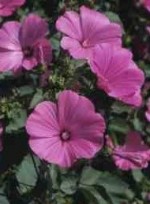 Check out the botanical name on this one because there are several plants that go by the name rose mallow. This plant is a large, bushy annual with the flowers that resemble hibiscus, a relative and member of the Malvaceae family. The flowers are not only large but they are also produced in abundance to make a very grand show all summer if they like the climate. Of course, this can be a problem. They are native to the Mediterranean region and so like cool evenings, warm days, and dry climates, not common to most of the U.S. This is a plant I don’t even bother with in my North Carolina garden but enjoy and cherish in southern California. If I really wanted to grow it in the South I could do so early in the season and just accept the fact that it is a short lived annual there. Since it is best started from seed, the outlay of money for the plant is not great; it does not like to be transplanted so is best planted directly into the garden. Known since at least 1833 it is an heirloom plant that would bring a nice touch of nostalgia to any garden. If you like to bring flowers in for the vase, this is a good one for flower arranging.
Check out the botanical name on this one because there are several plants that go by the name rose mallow. This plant is a large, bushy annual with the flowers that resemble hibiscus, a relative and member of the Malvaceae family. The flowers are not only large but they are also produced in abundance to make a very grand show all summer if they like the climate. Of course, this can be a problem. They are native to the Mediterranean region and so like cool evenings, warm days, and dry climates, not common to most of the U.S. This is a plant I don’t even bother with in my North Carolina garden but enjoy and cherish in southern California. If I really wanted to grow it in the South I could do so early in the season and just accept the fact that it is a short lived annual there. Since it is best started from seed, the outlay of money for the plant is not great; it does not like to be transplanted so is best planted directly into the garden. Known since at least 1833 it is an heirloom plant that would bring a nice touch of nostalgia to any garden. If you like to bring flowers in for the vase, this is a good one for flower arranging.
Type: Annual
Bloom: Pink or white saucer shaped flowers 2 ½-3” across are borne in the upper axils of the stems
Foliage: Three lobed leaves.
Size: 3-5’ H x 3’ W
Light: Full sun
Soil: Sandy loam, well drained’ drought tolerant once established.
Care: Low maintenance
Pests and Diseases: Japanese beetles
Propagation: Seed (plant directly into the garden as plants resent being transplanted); cuttings
Companion Plants: Flowering tobacco (Nictiana alata), tickseed, balsam
Outstanding Selections:
- ‘Dwarf White Cherub’ (white flowers, 12-15” tall)
- ‘Lovelliness’ (deep rose trumpet shaped flowers, 3-3 ½’ tall)
- ‘Silver Cup’ (iridescent pink flowere, well branched, 2-2 ½’ tall)
- ‘Mont Banc’ (white flowers, 2’ tall)
